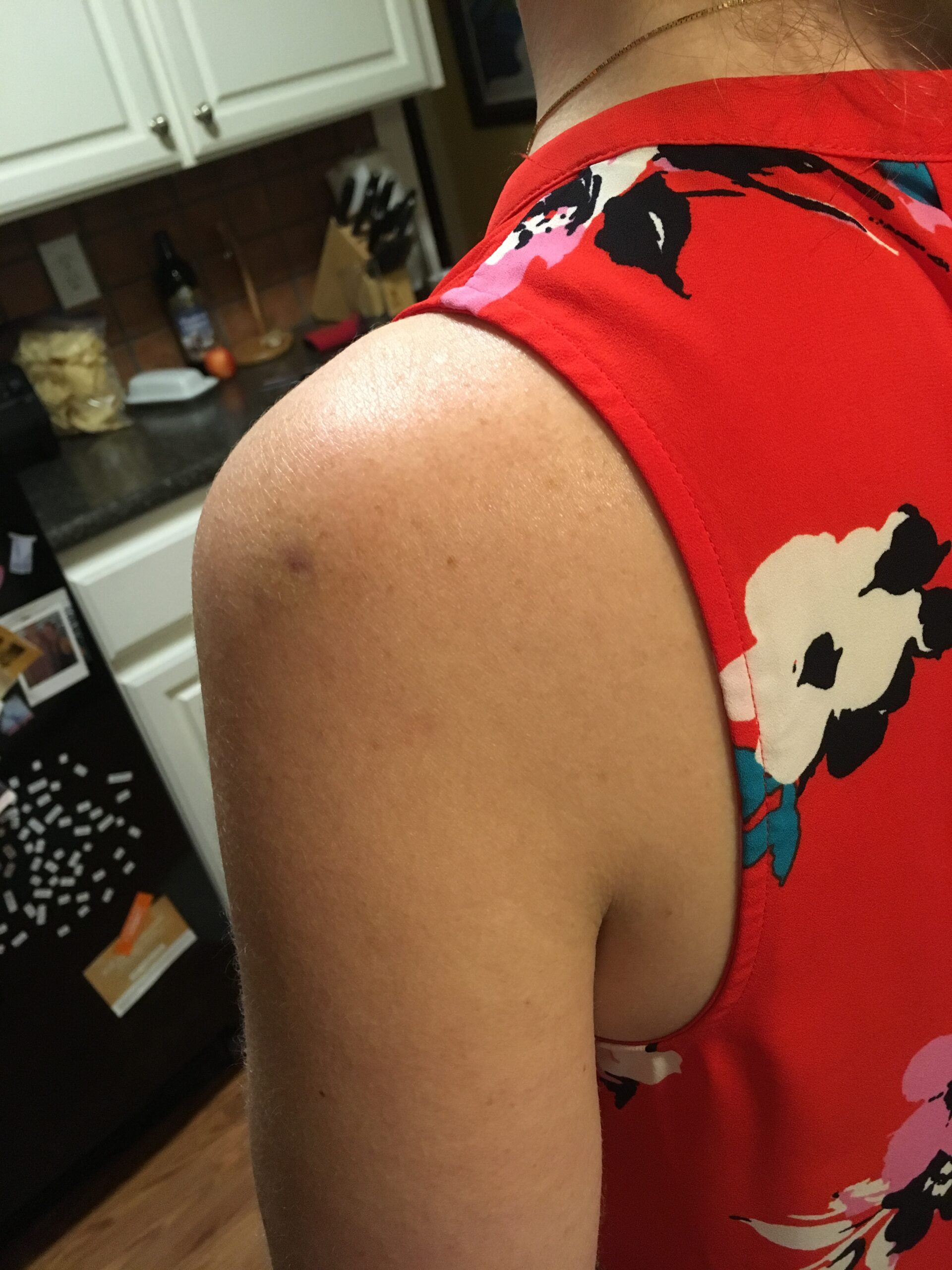Welcome to the second guest post on Shoulder Injury Related to Vaccine Administration (SIRVA). Before sharing Nicole’s story, I have a couple of updates:
- Please revisit this older post about the push to remove SIRVA from the Vaccine Injury Table – the move is now open for public comment and we need to hear your voices!!! Public comment on this very important issue for us is available until January 21, 2021. The rest of the post gives more information.
- Dr. Bodor, who I’ve mentioned several times on this website (e.g., here), has a video about SIRVA and about a new treatment technique he has pioneered, and a brief write-up on his website. I’m very excited to hear more results from this treatment!!
- Check out Ashley’s YouTube videos about her SIRVA experience.
- There are two Facebook groups that I’m aware of that provide a place for discussion about SIRVA. One is called “SIRVA – Shoulder Injury Related to Vaccine Administration” and the other is called “I have Shoulder Injury Related to Vaccine Administration (SIRVA)”. Search for those names on Facebook to find and join them.
Below is Nicole’s post about her SIRVA experience, which includes a difficult case of frozen shoulder (adhesive capsulitis). Frozen shoulder happens in some percentage of SIRVA cases (I promise to go through the data soon and discuss more of the percentages and data). In her post, Nicole discusses some valuable information she learned from her physical therapist about treating the frozen shoulder, and more thoughts on her two-year journey.
-Amy
On a sunny fall afternoon in 2018, I stopped by a local pharmacy chain to get my annual flu shot. I figured it would be a quick in and out service and I would be on my way. I had been meaning to check out this cute pharmacy to see the gift items and knickknacks they were known for. The pharmacist was talkative with me and with her colleagues, and I felt at ease as she was getting the vaccine ready. She kept talking as she leaned over me, not paying a lot of attention to how she was lining up the needle with my arm. I thought about saying something, but thought that there was no risk associated with getting a flu shot, even if it was a little off center. She knew what she was doing, I trusted her. But I should have said something.

November 2020 marks two years since I had my injection and my arm is still not fully recovered. The injection I received that day has caused years of pain, limited arm movement, countless hours physical therapy, and limitations to my daily tasks. But the good news is that in the past year, things have gotten significantly better. That’s the message I want to share with you – it’s a long road, but it can get better.
Since starting physical therapy here in San Antonio, my arm has gone from 90 degrees of rotation to 160-165 degrees in a one-year timeframe. That’s the difference between being able to only reach things at shoulder height, to being able to put things on shelves above my head. My arm hurts less regularly, and I only experience numbness in my pinky and ring finger once or twice a week.
In the summer of 2019, I received a diagnosis of SIRVA and was lucky to be able to be matched up with a fellowship program at Brook Army Medical Center. I learned that the primary issue I experience because of my SIRVA is adhesive capsulitis (also sometimes referred to as “frozen shoulder”), a tightening of the shoulder joint capsule which causes pain and muscle tightness. My therapist explained to me that my shoulder muscles created a cast to “protect” my arm which was immobilizing my joint and causing my pain.
My Physical Therapist focused his treatment plan on getting the muscles to relax and move little by little. I learned that if something hurt because I was pushing through pain to gain more movement during therapy, I could be prolonging my recovery. Instead of forcing a movement, I needed to ease up to avoid causing my muscles to continue to tighten up. I followed this idea at home too, movement is great – but if it causes severe or lasting pain, I needed to let up on my arm a bit.
In the fall of 2019, I was asked if I wanted to pursue surgery to quickly fix to my problem. But I try to avoid surgery as much as possible – it’s just not my jam. Instead I continued going to all of my appointments, dedicated the time for my home exercises (approx. 20 mins on a daily basis), and did my best to use my arm in daily tasks without aggravating it. I stayed active, doing exercises that didn’t seem to anger my arm like using the elliptical at the gym. Even my husband was enrolled in helping me with stretching and moving my joint at times.
Little by little I started seeing gains. By December, I could wash my hair comfortably; by February I was able to reach my bra hooks behind my back. As I gained more motion, my therapist and I could feel the adhesions breaking during therapy sessions. I was seeing progress which kept me motivated to continue stretching every day. Spending time stretching each day has become an investment in myself. My joint feels better, I am able to be more self-sufficient, and I am in less pain.
This August (2020), I was released from my physical therapy sessions. Now I am working independently on my own with a set of stretches to keep increasing the range of motion in my arm. Instead of my daily stretches, I am trying to identify what my minimum stretching requirement is to keep my arm feeling happy. If my arm gets bad again, I can always check back in for more assistance from physical therapy. I am finally able to reach things on high shelves, carry things using my left arm on its own, and even sleep on my left side at night. Most of the things around the house can be done on my own without aggravating my arm.
Thinking back on the past two years, here are my take-aways from my experience:
- Advocate for yourself: If you are getting another vaccination – make sure the person is placing it correctly. Use the resources that Amy has provided on this SIRVA Blog to educate others and to protect yourself. If your arm is not better after your Physical Therapy has ended, ask for more.
- Don’t push through the pain: If it hurts bad, you could be causing your arm to freeze up more. My Physical Therapist advised me that discomfort is ok as long as it goes away once you move out of the position or movement. But if the pain lingers, lighten up on the intensity of the exercise or movement. It will take a long time to get your muscles to relax, but they won’t relax if you cause them pain.
- Do your exercises diligently: It’s an investment in yourself – literally! Stretch while watching your favorite TV show, listening to a podcast, or listening to music. Find a way to create relaxing time for yourself while you do your stretches/exercises. Bring your PT bands (or other equipment) with you when you travel. Fit the work in – even if you cannot do it all on a particular day, fit some of it in. I believe that the long-term commitment to consistent stretching on my own has helped me make such great progress this year.
- Embrace the long path you are on: After my SIRVA and Adhesive Capsulitis diagnosis in the summer of 2019 I was told that it would take 1-2 more years for my arm to get better. I was already 10 months post injury at that time – so that’s a total of 3 years to heal. It is exhausting to think about, but by dedicating myself to doing my exercises I have seen progress and that has kept me focused on the long-term goal.
I know that I still have another year or more ahead of me to get my full range of motion back. Honestly, I may never get to 180 degrees of movement, but I am going to keep making progress in that direction. Recently I tried swimming, and some day 1-2 years from now perhaps, I will be able to go whitewater rafting again. Even if that doesn’t happen, I am in a much better place today than I was a year ago thanks to my Physical Therapist and to the work I have put into my arm. I hope this update inspired you to keep your eyes on the long-term goals and to do the little daily things that will help you get there.
